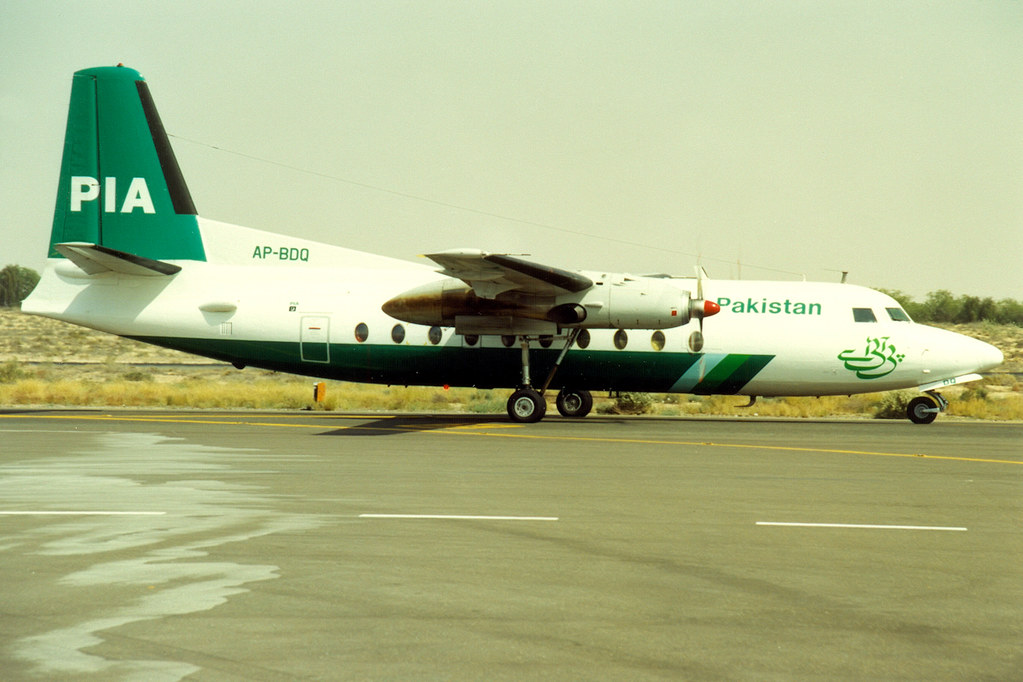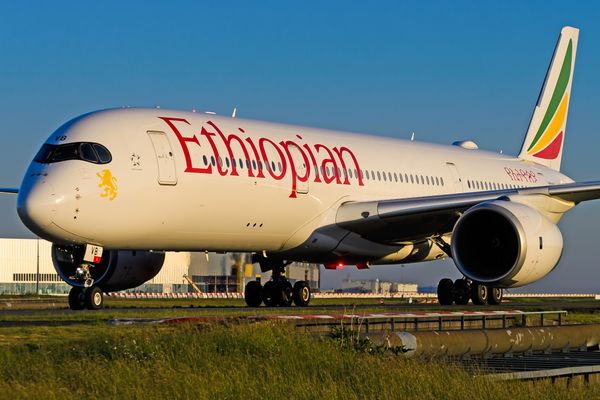This is the story of Pakistan International Airlines Flight 688, a shocking tragedy that highlighted the negligence of an airline and the ultimate price it had to pay.

Background
Pakistan International Airlines (PIA) once operated a fleet of 30 Fokker F-27 Friendship aircraft consisting of 24 F-27-200s, one F-27-400, and five F-27-600s. These aircraft operated domestic flights in Pakistan. Most of these planes were introduced to the airline in 1961, while the five F-27-600s were introduced in 1966 and retired in 1986.
On July 10, 2006, Pakistan International Airlines Flight 688 was preparing for a domestic service from Multan (MUX) to Islamabad (ISB) with a stopover in Lahore (LHE). The flight was operated by AP-BAL, a 42-year-old F-27-200 at the time of the incident, which had been built in 1964 and delivered to PIA in 1979.
Flight 688 carried 41 passengers and four crew members. The flight's passenger manifest showed that the passengers' final destinations were almost equally split. Twenty passengers were bound for Lahore, while the other 21 stayed onboard until Islamabad. Various notable individuals were onboard this flight.

These included Nazeer Siddiqui, the former judge of Lahore High Court, and the incumbent judge Muhammad Nawaz Bhatti. In addition, Mohammed Naseer Khan, Vice Chancellor of Multan's Bahauddin Zakariya University, and two army brigadiers were onboard. Ironically enough, Imtiaz Anwar, a PIA official overseeing the Fokker's fleet's airworthiness, was also onboard.
53-year-old Hamid Riaz Qureshi, a Pakistan Air Force Academy graduate in Risalpur, captained flight 688. Qureshi had a total flying experience of 9,320 hours and had been with PIA for 17 years, having joined in 1989. The First Officer was 28-year-old Abrar Azhar Chughtai. One glaring red flag about this duo was their notable low experience flying the Fokker F-27. Captain Qureshi only had 138 hours flying the type, while First Officer Chughtai had 303 hours.
Immediate Issues
Flight 688 departed Multan on time bound for Lahore. The weather was described as "good condition," and the aircraft was designated as "fit to fly." As the F-27 rolled down the runway, it was at the 60-70 knot mark when the crew noticed that one of the pumps had malfunctioned. Shortly after realizing this, the plane began veering right. The crew could correct the aircraft's course and keep it centered for the rest of the runway.

Once the plane reached 90 knots, Captain Qureshi asked First Officer Chughtai if the engine's torque had decreased, to which Chughtai replied with "affirmative." Five seconds later, the aircraft reached the "V1" speed. The "V1" speed is the maximum speed at which the crew of an airplane can choose to reject the takeoff. It's also the minimum speed at which takeoff can be continued following an engine failure.
When Flight 688 reached its V1 speed, the crew continued the takeoff despite something wrong with the aircraft. The F-27 became airborne at 120 knots. Not long after lifting off, the aircraft's auto feather system activated. "Feathering" is a feature unique to propeller aircraft that sees the propeller blades increase their pitch angle by turning parallel to the airflow. This is meant to minimize drag that would occur from stopped propeller blades.
The right engine, which the crew confirmed was suffering from lower torque, suffered a flame out and began to spool down. The crew responded to this by manually feathering it. As the Fokker was climbing out of Multan, an air traffic controller noticed smoke from the afflicted right engine. Captain Qureshi was notified of the situation and decided to attempt a return to Multan Airport.

Tragedy Strikes
Due to the right engine's issues, the F-27 began to bank several times, all with its landing gear still extended. Failure to retract the gear further compromised the aircraft's aerodynamic capabilities, as this caused more drag. Reportedly, the plane only reached 150-160 feet (46-49 meters) before stalling. Farmers at a nearby mango garden saw the plane diving towards them, and they were able to run and get out of the way.
Flight 688 impacted the ground in the garden area, later hitting some trees and a mud wall before skidding on the ground. During the skid, the F-27's nose caught a ditch that caused the plane to flip and land on its back. As the aircraft flipped forward, the tail separated and struck an electric wire. The F-27 came to rest upside-down, and the 4,700 tons of fuel were soon ignited, causing a massive fire.
Terrifying reports from residents suggest that "faint screams" could be heard from survivors soon after the plane came to rest. Attempts were made to rescue those trapped inside the plane; however, the intense blaze prevented any immediate rescue attempts.

One flight attendant was pulled out alive but sadly passed away en route to the nearest hospital. Fire brigades reached the crash site within the next five to six minutes. By this time, most of the wreckage had completely burnt, taking the lives of all onboard.
Aftermath
Condolences on behalf of various governmental officials were soon offered to the families of those lost onboard Flight 688. Furthermore, events in Lahore were canceled, and the city's High Court was temporarily closed following the deaths of the two judges.
A PIA spokesman stated that the victim's next of kin would be given compensation of up to 500,000 Pakistani Rupees. Currently, that's worth around $1789, thanks to the massive devaluation in the Pakistani rupee. Rs. 500,000 was equivalent to a much higher dollar amount in 2006.

The Air League of PIA's Employees Union charged the airline administration with being responsible for the crash, arguing that flights were operated with inadequate crew numbers and that substandard overhaul work was carried out on aircraft, among other flaws. Other PIA employees accused the airline of being short on maintenance workers as, at the time, around 30 senior engineers had left the airline earlier that year for better opportunities, primarily in the Gulf.
There was an overall negative sentiment from the public regarding the safety of PIA's Fokker F-27 fleet, which was pushing 40 years of age. Soon after the Flight 688 tragedy, PIA retired its entire fleet of Fokker F-27s, replacing them with newer ATR-42-500 turboprop aircraft.
Investigation
Time and time again, concerns have been raised regarding the condition of the aging F-27 fleet. Both of the flight crew on PK-688 had complained regarding the fleet's airworthiness. PIA, however, continued to reiterate that the Fokker planes were airworthy and certified to fly. The airline's then-Deputy Managing Director, Farooq Shah, claimed that there were no recorded defects of the involved F-27 in the preceding 15 days.

Investigators visited the crash site on the same day of the accident. Recall that as the plane took off, Multan ATC reported fire emanating from the right engine. Sure enough, metal debris was found scattered throughout the runway.
It was later found that this debris was part of the F-27's right engine turbine blades. Two bolts that held the bearing of the right engine's rear turbine had cracked due to stress. This stress was caused by improper assembly during PIA's most recent engine overhaul in September 2005.
Fokker, who became involved in the investigation, maintained that the F-27 could safely conduct a single-engine operation from any phase of flight. Flight 688 crashed five minutes after takeoff, putting into question the flight crew's experience with flying the F-27. As explained earlier, both pilots had a surprisingly low number of hours flying the type, particularly Captain Qureshi, who had 138 hours.

During the incident, the cockpit crew's action was described as "lacking in professionalism, displaying poor airmanship, and extremely poor emergency handling." The investigation's final report attributed the cause of the accident as "complex" yet deeply rooted in the organization and culture of PIA.
Despite retiring the F-27 after the Flight 688 incident, PIA did not significantly improve its maintenance culture. This, unfortunately, led to the 2016 crash of PIA Flight 661, an ATR-42, that crashed under similar circumstances to Flight 688. In its 45 years of operation with PIA, the Fokker F-27 fleet became infamous for a variety of incidents that, in total, claimed the lives of 172 people.
The most infamous was the case of PIA Flight 404, an F-27 that disappeared in the Himalayan Mountain range shortly after departing Gilgit for Islamabad in 1989. To this day, the wreckage of Flight 404 has not been found. This incident is rumored to have played a part in the computer error message "404 - Not Found"; however, there has never been any confirmation.
This article was written in memory of those lost on Pakistan International Airlines Flight 688.
Mexican Medical Plane Crashes in Galveston Bay During Rescue Mission » IndiGo Unveils Delhi–London Expansion and First A321XLR Launch » End of an Era: JetBlue's Farewell to the Embraer E190 »
Comments (0)
Add Your Comment
SHARE
TAGS
STORIES Pakistan International Airlines Pakistan Crash Incident PIA History Fokker F-27 Fokker Safety EmergencyRECENTLY PUBLISHED
 VIDEO: What It's Like Onboard China's COMAC C919
We flew onboard China Eastern's COMAC C919 to experience China's homegrown narrow-body up close. From seat comfort to cabin layout to noise levels to tech: how does it really compare with the Boeing 737 and Airbus A320? This review puts all three workhorses under the same spotlight.
TRIP REPORTS
READ MORE »
VIDEO: What It's Like Onboard China's COMAC C919
We flew onboard China Eastern's COMAC C919 to experience China's homegrown narrow-body up close. From seat comfort to cabin layout to noise levels to tech: how does it really compare with the Boeing 737 and Airbus A320? This review puts all three workhorses under the same spotlight.
TRIP REPORTS
READ MORE »
 KAL858: The North Korean Bombing that Shocked the World
Among the 99 passengers boarding Korean Air Flight 858 on November 29, 1987, few could imagine their journey would end as one of aviation's darkest mysteries.
STORIES
READ MORE »
KAL858: The North Korean Bombing that Shocked the World
Among the 99 passengers boarding Korean Air Flight 858 on November 29, 1987, few could imagine their journey would end as one of aviation's darkest mysteries.
STORIES
READ MORE »
 Ghost Networks: The Rise, Fall, and Revival of Fifth-Freedom Flights
Fifth-freedom flights — routes where an airline flies between two countries outside its home base — have always lived in aviation's twilight zone. We chart their rise, their near-disappearance, and the surprising markets where they still thrive today. Then we take you on board a special Seoul-Tokyo fifth-freedom flight to show how the experience stacks up against a typical regional carrier.
TRIP REPORTS
READ MORE »
Ghost Networks: The Rise, Fall, and Revival of Fifth-Freedom Flights
Fifth-freedom flights — routes where an airline flies between two countries outside its home base — have always lived in aviation's twilight zone. We chart their rise, their near-disappearance, and the surprising markets where they still thrive today. Then we take you on board a special Seoul-Tokyo fifth-freedom flight to show how the experience stacks up against a typical regional carrier.
TRIP REPORTS
READ MORE »



